-

-

-

-

-

-
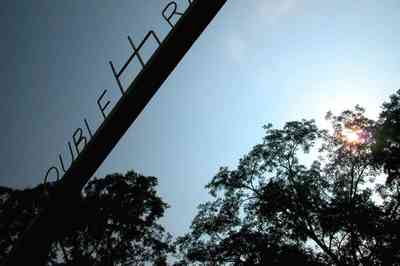
The ranch is located on Highway 87 North.
-

The picturesque ranch is a cattle farm.
-

-

-
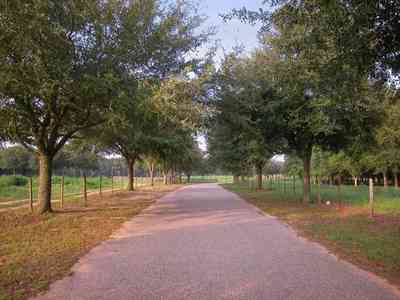
-

-

-

-

Whimsical sculptures and signs can be found on the Matthews farm.
-

The property is divided into fenced tracts.
-

It is unusual to find limestone rocks on the surface in the area.
-

There are about 100 head of cattle in this herd.
-

Steve Matthews feeds treats to the cows.
-

-
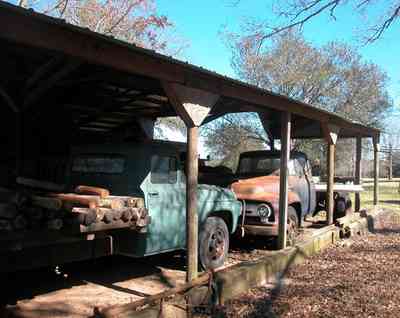
-
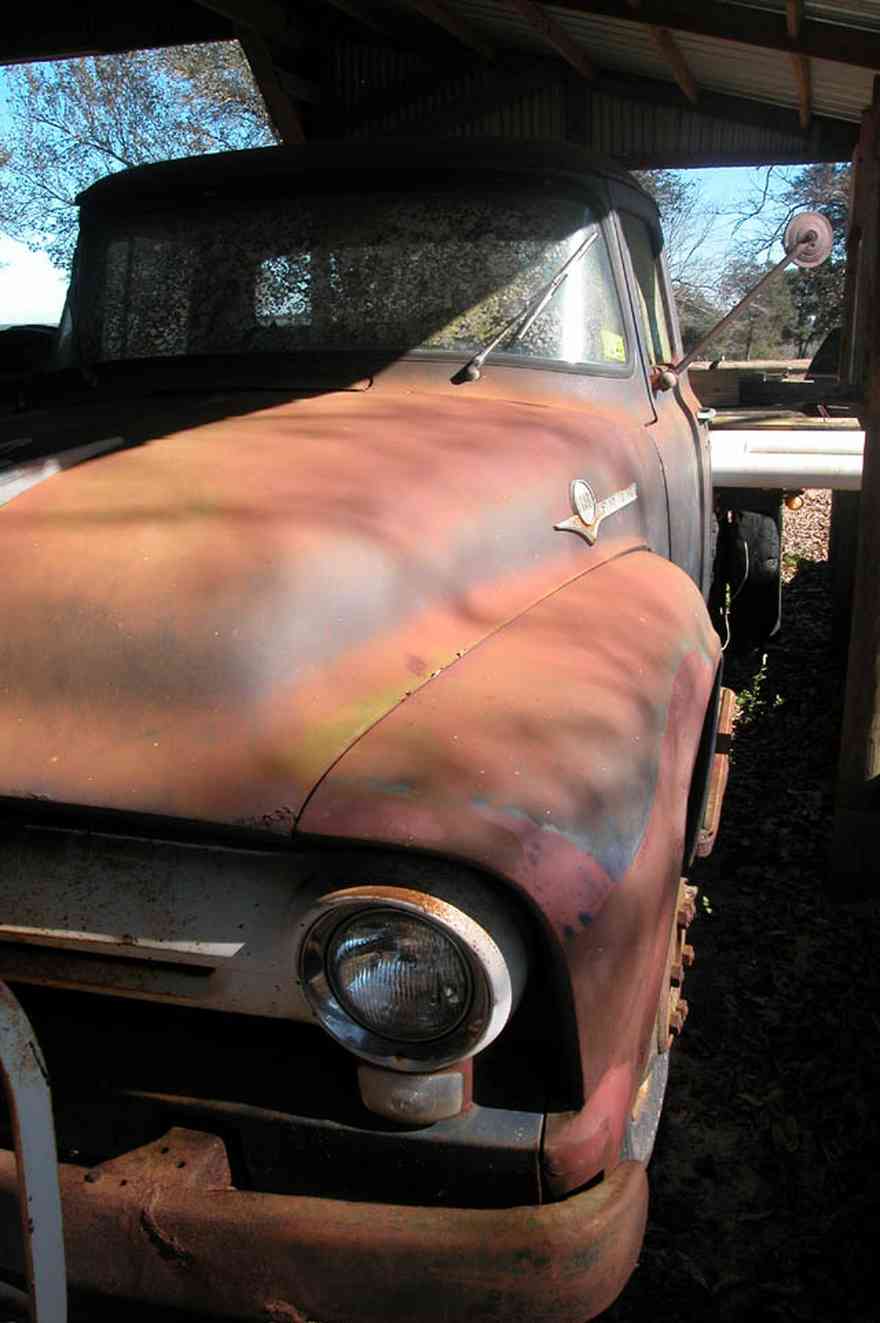
-

Cattle graze on the extensive acreage.
-

-

The farm is located on Hopewell Road.
-

There are two entrances on either side of Hopewell Road. This is the south gate.
-
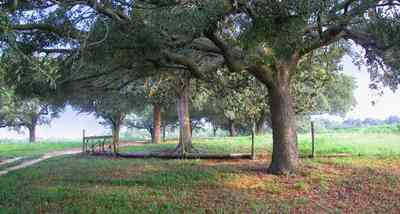
The south road is lined by an avenue of young live oak trees.
-

The narrow dirt road is a private driveway.
-
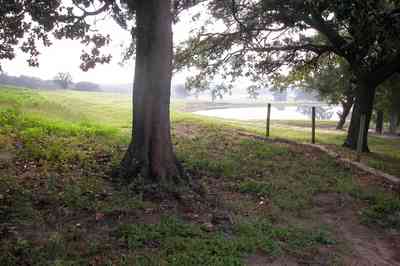
The road follows the gently rolling hills.
-

There are several lakes in the valley. The road winds around the lakes.
-

-

-

A branch of the Coldwater Creek flows through the Matthews property.
-

The highway curves around newly planted fields.
-

The farmland is located on a ridge of hills above the Blackwater River basin.
-

The framed mirror hangs on a wall in the "dog trot" alongside of the kitchen door. It was used for grooming and shaving and was usually the only mirror in the house.
-

Bennie Barnes visits the Brown family.
-

Luke Brown is a champion calf roper on the rodeo circuit. He uses this trailer as headquarters on the road.
-

Luke Brown stands at the rear of his custom horse trailer.
-

The horse trailer is partitioned into a stall for the horse and living quarters for Luke.
-

Luke's quarters are in the front of the trailer.
-

-
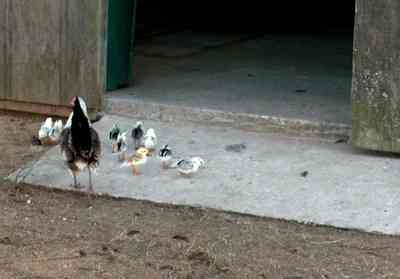
-
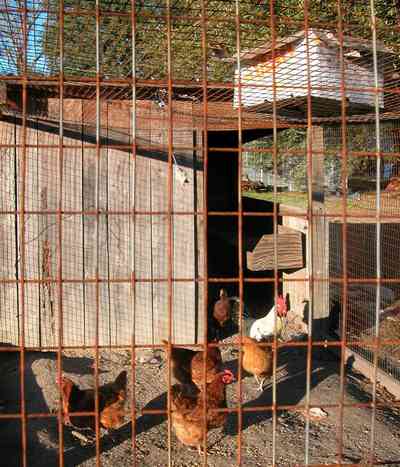
-
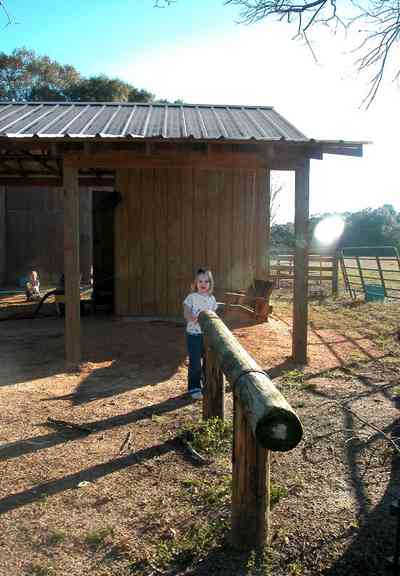
-

Dan Stewart and associates act out a number from the movie, "Brother Where Art Thou".
-

Customers buy bags of peanuts at the Holland barn.
-

The front of the farm faces Kleinschmidt Road. The deciduous trees are pecans. There is a grove along the property line on the east side of the farm. The Heil home is a small craftsman cottage in the center of the frame.
-

A dirt road runs alongside of the east field. Rolls of irrigatioin equipment and outbuildings can be seen in the right side of the frame. The greens can be seen int he center. There is a utility line alongside on the far left.
-

The utility buildings and irrigation equipment can be seen in the distance along the tree line.
-

-

A pecan orchard frames the field of greens along the dirt road.
-

Much of the produce in the area is grown in the Elberta farm community.
-

The dirt road and the farmland are barely distinguishable.
-

An abandoned farmstead nestles among pecans and oaks beside the highway.
-

Pecan trees line the road. There are numerous old orchards on this flat plain.
-

The narrow dirt road runs alongside fields of vegetables
-

Piles of watermelons are purchased from July to August at the barn.
-

Bruce and his family have a complete peanut harvest from planting through boiling.
-

The 600 acre farm is divided into summer crops. The butterbean field is adjacent to the barn.
-

Melvin Holland lends a hand during the butterbean harvest.
-

Charles Holland supervises the bagging of beans.
-

Bruce and Melvin Holland are standing in one of the corn fields where the current crop is Silver King corn.
-

Melvin Holland samples the Silver King corn.
-

Diane Holland cleans the Silver King corn. She is planning a cream style corn recipe.
-

Produce such as, the cucumbers displayed by Bruce Holland is sold at the nearby barn.
-

Bruce Holland demonstrates soil quality in one of the north fields. The tilled area represents about five acres.
-

The field is being prepared for the next crop. Soil composition varies widely from field to field. The soil in this area has a high organic content. Soils are composed of sand, clay and organic materials.
-

The entrance to the barn and house is on the far right of the photograph. The 5 acre tilled field can be seen on the other side of the road.
-

A crew of local workers pick the beans.
-
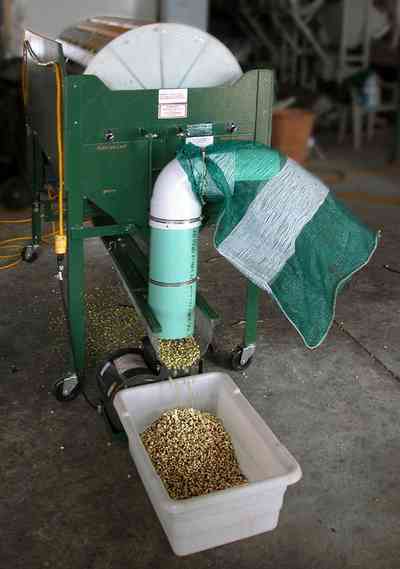
Pods are cleaned automatically.
-

Zipper cream peas are a popular variety. Some seed varieties appear to have no distinguishing eye color or body color other than that of white or pale, these seeds are said to have “no color”, and they are classified as “Creams”. The color of the seed itself determines the color of the broth when cooked. The darker the seed color the darker the broth. Seed with “no color”, white or pale, gives a clear broth. Zipper Cream Peas have a clear colored broth. The name Zipper came from the ease of unzipping the pea pod to expose the seed.
-

The Bruce Holland farm complex is located on Homer Holland Road in Santa Rosa County, Florida. The peach trees seen in the photo produce about six bushels/60 pounds or 120 one-half pound peaches per tree.
-

Bruce Holland is seen in the foreground of his peach orchard in northwest Florida. The trees have been planted in symmetrical rows every year for the past six years. The orchard has approximately 200 trees, all bearing fruit.
-

The immature peaches shown above will be ready for picking in May and June, depending on the variety of tree. Mr. Holland also grows cantelopes, watermelons, butterbeans, peas, peanuts, and cotton. He has a booming retail business located out of his barn. The vegetable and fruit havest begins in May with the sale of peaches, cantelopes, and watermelons.
-

-

The peanut is a nitrogen-fixing plant. The roots form nodules, which absorb nitrogen from the air and provide enrichment and nutrition to the plant and soil.
-
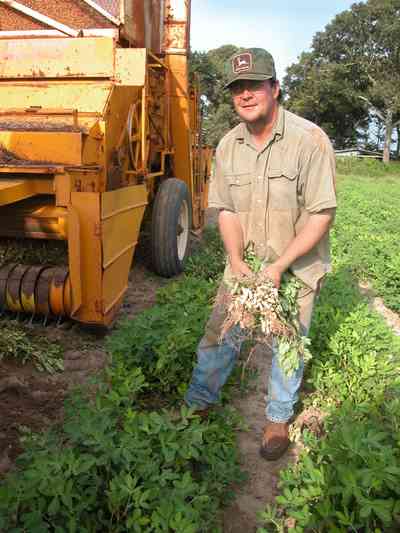
From planting to harvesting the growing cycle takes about four to five months, depending on the variety.
-

Peanuts are actually legumes - not nuts.
-

Holland Farms produces a variety of crops throughout the year. Listed below are prices for vegetables that are currently being harvested. For further information, call - 675-6876.
-

-

Bruce Holland inspects the cucumbers planted along a low fence.
-
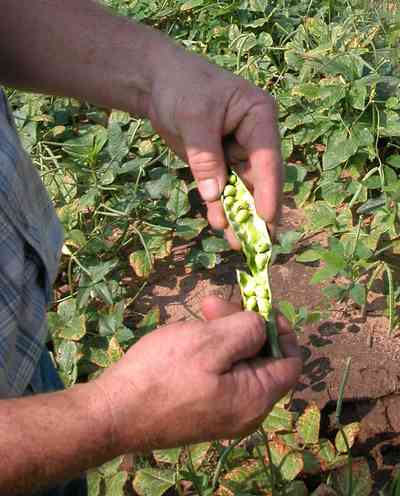
Zipper cream peas are one of several varieties ready for harvesting.
-

Green peanuts are available.
-

Yellow crookneck squash grow in the garden south of the main barn.
-

Royal Star and Starbright Watermelons are the varieties of watermelons grown for harvest.
-

This 15 acre field was planted in butterbeans. It is irrigated with water from a nearby holding pond.
-

The irrigation line bisects a thirty acre field. The southern portion, show above, has been planted with pumpkins. The line of deciduous trees grow along Homer Holland Road.
-

The Holland farmhouse can be seen through the trees. The driveway is typical of dirt roads and driveways which are composed of red clay.
-

Hundreds of watermelons are sold at the barn every summer beginning in late June.
-

Africa is considered to be the native home of the watermelon.
-

On the American continent, watermelons were grown as early as 1629 in Massachusetts, and prior to 1664 in Florida.
-

Watermelons grow best on a sandy loam soil.
-

Today there are more than 100 different varieties of watermelons. The flesh may be red, pink, orange or yellow.
-

The sweetest watermelons grow during long hot summers.
-

Ninety percent of watermelon is water.
-

Watermelon vines require considerable space. Seeds are planted one inch deep in hills spaced 6 feet apart. As the watermelon plants grows, the vines converge and the field becomes a sea of green vines.
-

The watermelon require a long growing season with relatively high temperatures. Daytime temperatures between 70 and 80 degrees F and nighttime temperatures between 65 and 70 degrees F are ideal.
-

Probably the most important indicator of ripeness is the underside which sets on the ground. Turn the melon over. It should be yellow or creamy colored on the underside. If it is white or pale green the melon is not ready to harvest.
-

Once picked, uncut watermelon can be stored for about 2 weeks at room temperature.
-
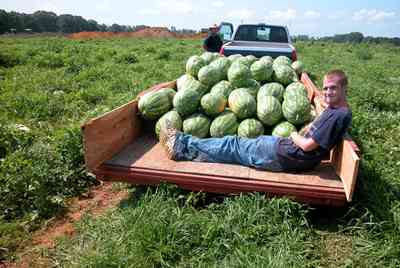
The flesh of the melon should be deep colored with mature seeds. Most watermelons have dark brown or black seeds.
-

Harvesting is particularly critical because watermelons do not continue to ripen after they have been removed from the vine. They should be picked at full maturity.
-

Watermelons are low in calories and very nutritious. Watermelon is high in lycopene, second only to tomatoes.
-
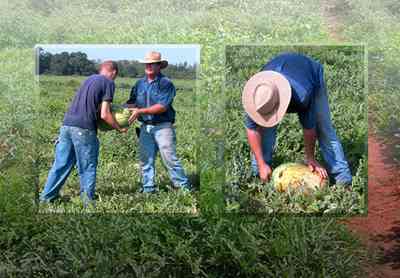
Watermelon is also high in Vitamin C and Vitamin A, in the form of disease fighting beta-carotene. Research also suggests that the red pigmented foods provide this protection.
-

Squash are harvested when five to six inches long. Keep the squash picked as flavor and texture will be inferior if the vegetable is left to grow to enormous size on the plant.
-

The Holland family settled the area over 100 years ago. Bruce Holland is a well known farmer who sells produce at his barn on Hwy 178. His farm has been featured on the WEAR TV 3 feature "Our Acre".
-

The church is located at the corner of Chumukla Highway and 178.
-

The little church is nestled between cotton fields in western Santa Rosa County.
-

Sycamore trees line Highway 178 at Sundance Farm.
-
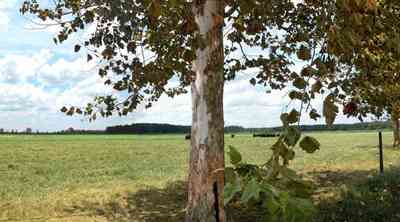
The range of the sycamore tree is northwest Florida and can be found throughout Santa Rosa and Escambia counties.
-

The craftsman style cottage is evocative of the farm houses of the 1920's and 30's. It sits on the edge of a cotton field.
-

Americans are eating more peanuts overall; more peanut butter and more snack peanuts.Total peanut consumption has been on the upward trend since 1996. Snack peanuts are up by 13.3 percent over the past year.
-

The small town center features a line of unique brick store-fronts in red brick trimmed in yellow.
-

Melvin Holland sells peanuts at the festival.
-

There is a display of John Deere® tractors alongside of the farm museum.
-

An original water well is located east of the farm house.
-

-

-

-
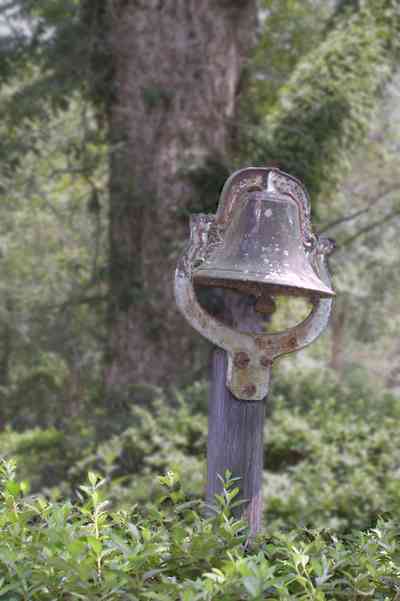
-

-

-

There is an oak grove located on the west side of the property.
-

The entire western property line is shown in this photograph. The green field on the left is a winter wheat paddock.
-
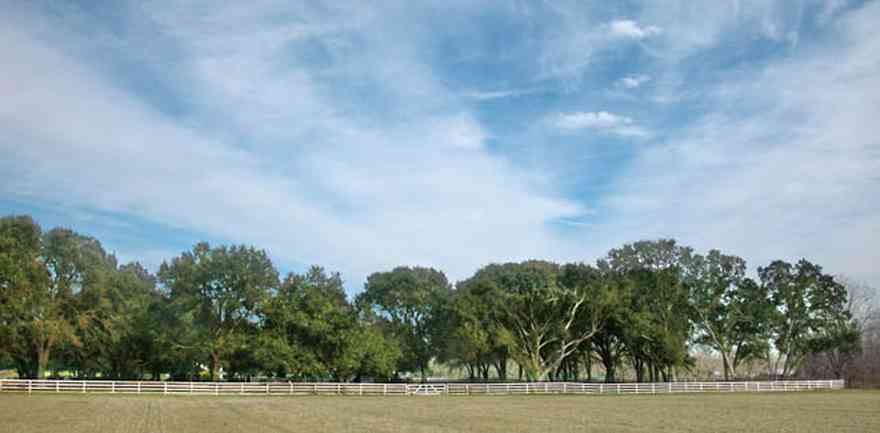
The board fence separates the horse farm from the neighboring estate.
-

Interior fences are electrical, lined on the top with a white mesh tape.
-

-

There is a old growth forest of long-leaf pines surrounding the cleared acreage.
-

-

-

-

-

-

-

-
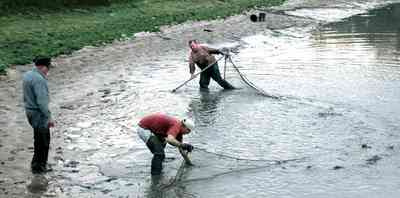
-

-

Womack Road is about three miles north of the town of Milton in Santa Rosa County.
-

There is a small restaurant about one mile from Munson Highway
-

A windmill and chimney are all that remain at the old farmstead along a dirt road in northern Escambia County.
-

Fields of winter wheat are planted as grazing land.
-

-

-

-

-

George Carpenter holds a 3 pound catfish which is an average size for the pond.
-

Grace takes a rest with her mother, Kaye Perry, George and Martha's daughter.
-

Donnie Waters is extracting the hook from the mouth of the catfish with the assistance of George Carpenter.
-

Each catfish is weighed. The average catfish costs $1.50 per pound when the fish is caught at the pond.
-

Mayor Bennie Barnes hooks a large catfish. He and Donnie Waters are planning a fish fry for Margorie Waters who is retiring from her job with the City of Century. It takes about an hour for the Mayor and Donnie to catch 20 fish.
-

Mayor Barnes carries his fish to the scales for weigh-in.
-

Mayor Barnes has the prize catch of the day.
-

Mayor Barnes records the weight of his prize catch just before it is cleaned.
-
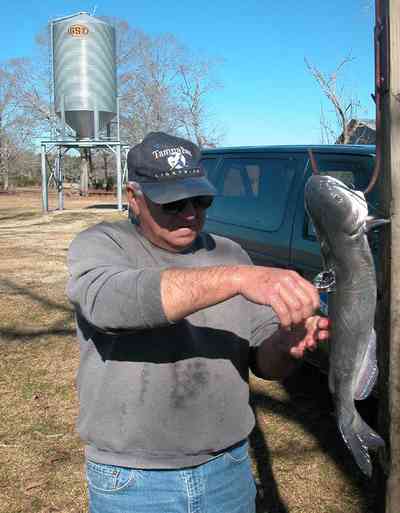
George Carpenter begins a demonstration of cleaning catfish by cutting off the spiny central fin.
-

The silo in the background holds 15 tons of catfish food. Catfish food is fed in pellet form. It is a high protein diet composed of fish meal, soybeans, corn, and wheat. In the summer, the catfish at the Carpenter pond consume a ton of food each day.
-

The feeding machine is mounted in the back of a pickup truck. Feed is sprayed about 20 feet over the pond. The small pellets are snapped up by the catfish. During the summer season, the fish can eat one ton of food per day.
-
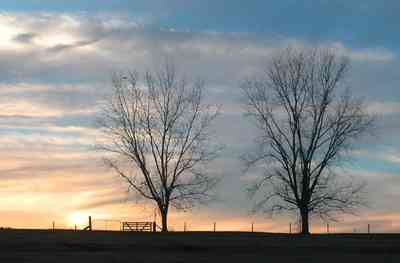
This specatular sunset can be seen from the Carpenter's kitchen window.
-

There is about 3,500 pounds per basket or 1,167 fish are retrived with each scoop.
-

There are no chemicals used in the pond. it is a totally controlled environment. A sample fish is sent to the processing plant for assessment. Tasters at the plant decide when the fish are ready for harvest. A select few fish from each load are ground up and anaylzed for chemicals by the USDA.
-

The oak canopy forms an umbrella over the home. John Michael Roush and Tiffy explore the yard.
-

Peanuts are grown on the 35 acre field adjacent to the homestead.
-

The boots were nailed to the trunk of the oak tree by Jeff Thompson's widow shortly after he died 25 years ago. He is the great-grandfather of John Michael Roush.
-

The vernacular farmhouse can be seen as an attempt to return to the good old days, with a rocking chair on the front porch.
-

Charles Holland assists Bruce in the sales department.
-

-

Pecan trees divide the homestead's driveway from the adjacent fields.
-

-

Corn is one of the crops grown in the Menonite community of Walnut Hill. There are several hundred acres of field corn planted for summer harvest on this farm.
-
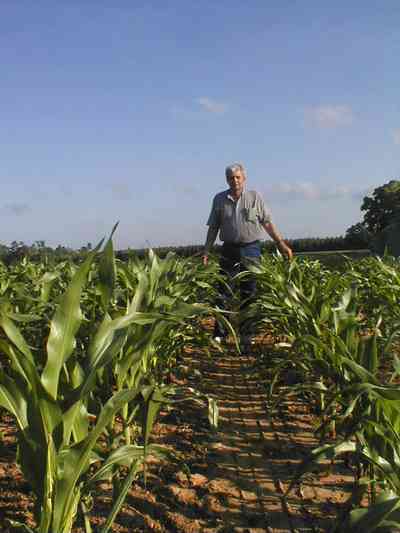
-

A stand of pine trees can be seen on the left of the photograph. Cattle are grazing in the valley.
-

Walnut Hill is an area of gently rolling land settled by Mennonite farmers from Kansas.
-
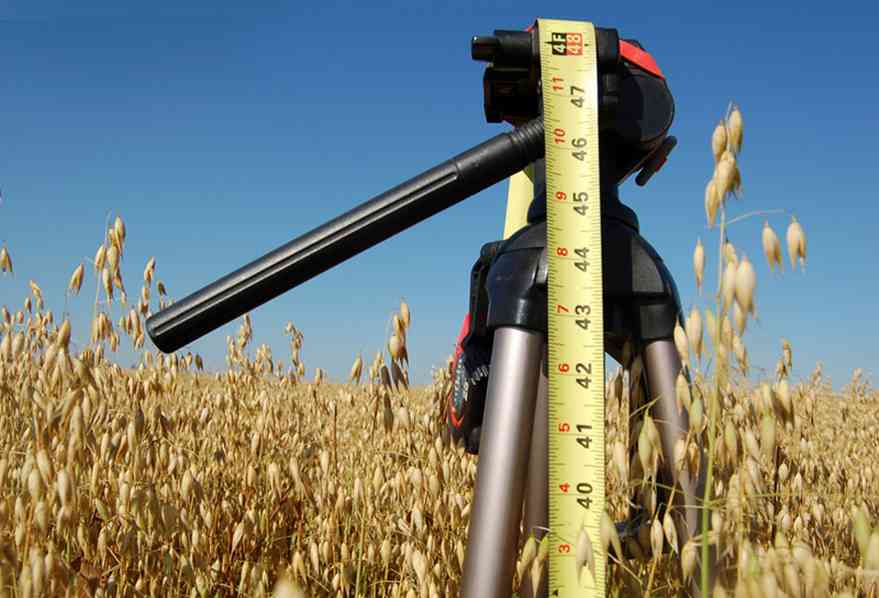
Stalks range from 36 inches to 42 inches.
-

The plowed field is planted in winter wheat.
-

Cattle graze on the winter wheat.
-

Rolls of hay can be seen on the left of the photograph.
-

The farm is located on Highway 97.
-

The house harmonizes with its surroundings because of low broad proportions and lack of ornamentation.
-

The facade of the home faces west. There is an overstory of large water oaks. An adjoining garage apartment can be seen at the end of the driveway with the barn immediately to the rear.
-

The style of architecture is often referred to as Craftsman. These dwellings display a fine degree of craftsmanship and are constructed of materials left as close as possible to their natural state.
-
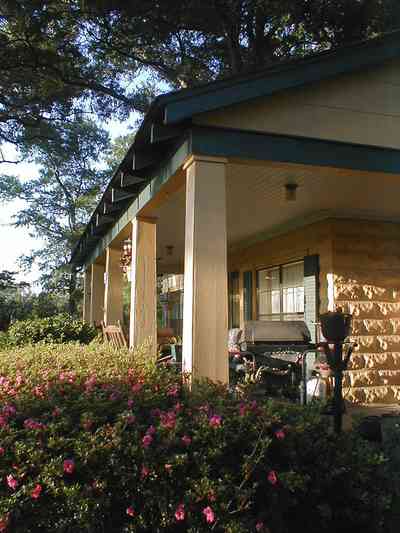
The walls are laid in quarried stone.
-

The conical building is used for drying corn.
-

The lean-to on the side of the barn is used as a chicken coop.
-
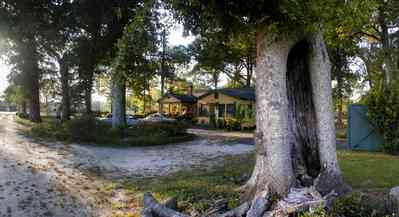
The driveway off Highway 97 is on the left of the photograph.
-

Oak trees line the cotton field adjacent to the Escambia Grain Coop silos.
-

This is the only farm cooperative grain elevator in northwest Florida.
-

There are three main buildings in the complex. The office is on the left, the grain elevator is immediately behind the office building and the fertilizer house is on the right of the photograph.
-

The opening under the main structure is the main access for loading and unloading truck loads of farm products.
-
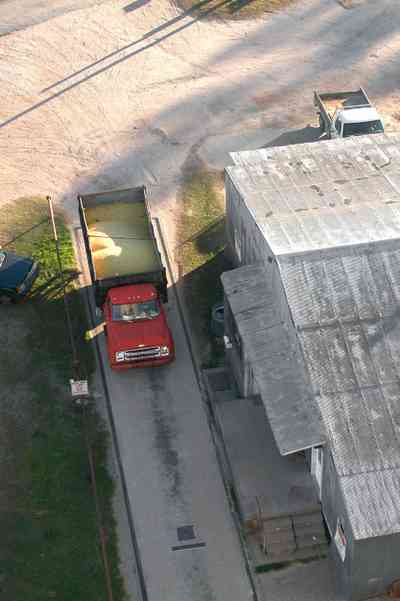
Trucks enter and stop at the office for a weigh-in to establish the amount of product before unloading.
-

The soybeans are unloaded into "the pit", a 30' underground storage space. Commodities are purchased from the farmers, stored and sold to consumers in amounts up to 5 tons.
-

The same area serves as a loading bay. A flow of corn is released from the storage silo. Customers range from hunters and farmers to sales of corn by the truckload, shipped overseas from the port in nearby Mobile.
-

This small elevator services the main silo.
-

The pipes feed into 18 different bins, storing individual items, such as, wheat oats, milo, soybeans and corn. Corn is the main item in storage at the elevator.
-

The conveyor belt moves corn up to the top floor of the grain elevator. The belt must be cleaned by hand.
-

The conveyor belt runs the length of the bins.
-

An auger turns the dispensing chute.
-

The bins are numbered and the feeding tube is positioned over the correct storage area.
-

White corn dust covers surfaces in the elevator.
-

A spectacular view of Walnut Hill can be seen from the top of the silos. Hundreds of acres of farmland stretch to the northern horizon.
-

Fertilizer is stored, mixed and sold in a seperate building. The bags shown above are loaded by hand after customing the mixture of the elements, such as, amonium nitrate, potash, etc.
-

The bobcat is used to load scoops of ingredients in the fertilizer mix.
-

Clay Stuckey demonstrates one of the tasks in the fertilizer house. The fertilizer is dumped into this grate. A scale weighs the material and it is mixed in a hopper. The finished product is distributed by truckload or by 50 pound bag.
-

Pre-packaged materials in 50 pound bags are stored in the building adjacent to the front office. The bags contain fertilizer and seed, as well as feed for any livestock.
-

After unloading, the truck is weighed empty to establish the amount of the load. The amount of the sale depends on current market price. A ticket is added to the farmer's account.
-

The rear door to the office is located to the right in the photograph.
-

The scales are connected to an electronic weighing system in the office.
-

Five employees run the elevator operations. Merle and Clay are in charge of outside tasks. There are two secretaries, Sue and Evon, as well as a general manager, Ed Nowlin. The elevator provides a central meeting place for some members of the farm community.
-

Gobbler Road is in the Walnut Hill Community off Highway 97.
-

There are thousands of acres in cultivation in the Walnut Hill community planted in a variety of crops.
-

The 60 acre field is located on Highway 97 in the Walnut Hill community.
-

-

-

-

-

There are several dairy farms along Kansas Road.
-

Round hay bales dot the fields near Walnut Hill.
-

There are catfish ponds on both sides of the dirt road.
-

The pond is the foreground is one of many catfish ponds in the area. There are over 1,000 such ponds in the neighborhood.
-

-

All of the land fronting on Kansas Road is under cultivation as row crops or in use as pasture land.
-

There are cotton fields stretching for several miles on both sides of Kansas Road.
-

Mennonite farmers are making agriculture a viable way of life in Escambia County.
-

Mike Godwin stands next to an airplane that he is rebuilding.
-

-
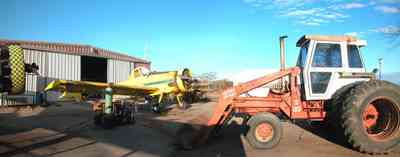
-

-

The corn crop will be used for silage to feed dairy cattle.
-
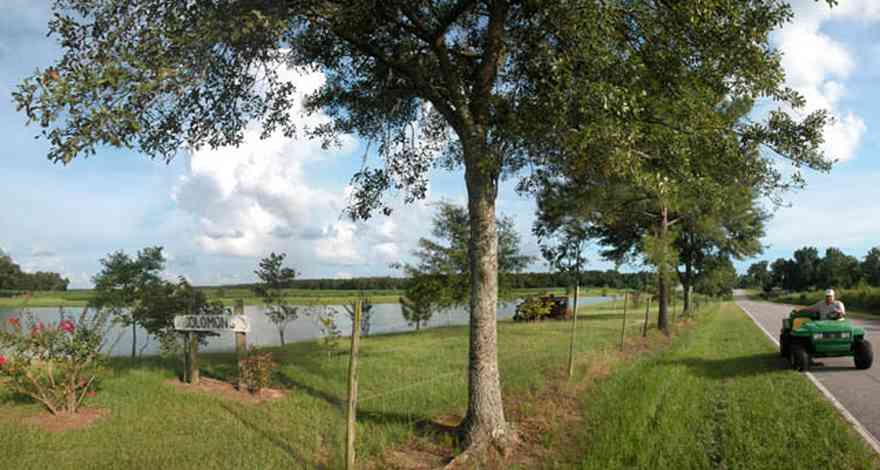
-
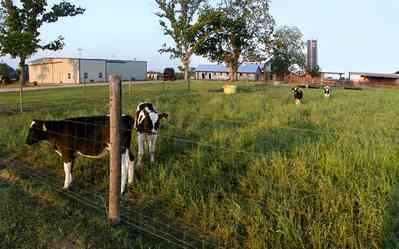
The Van Pelt Dairy Farm is located on Highway 97 in the Walnut Hill community.
-

Hundreds of acres of feed corn are grown along Highway 97.
-

In between corn fields there are pastures were the dairy cows graze.
-

Corn fields front Highway 97 for several miles.
-

The south end of the Van Pelt Dairy Farm is bordered by Gobbler Road. There are approximately three miles of corn fields along Gobbler Road which end to the east on Sandy Hollow Road.
-

The heifer barn is on the right. The milking barn is in the center of the frame.
-

The cows are leaving the milking barn. They are milked in shifts of 16 cows. The entire herd is processed between 1:40 a.m. and 6:30 a.m. and again in the afternoon beginning at 1:00 p.m. finishing around 5:30 p.m..
-

There are three milkers who work in two shifts every day.
-

Jan McCune places the milking machine on the cow’s udders. The machine pulls a 30 pound pressure to complete the evacuation process in 5 to 15 minutes depending on the quanitity of milk.
-

Jan gets a “kiss” from her favorite Mama cow, No. 62. Cows wear collars and are named by number.
-

No. 62 is a friendly cow. The cows are in a holding pen, waiting to be called into the milking barn.
-
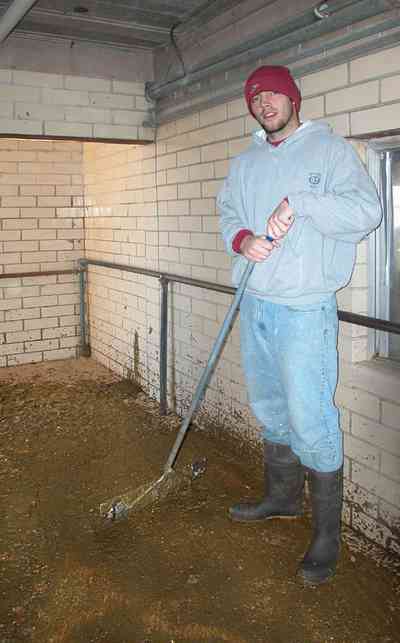
Cleaning the milking barn floor during shifts is a continous task.
-

Jan explains the gestation tabulator. The cycles and pregnancy of each cow is plotted.
-

George Van Pelt demonstrates the process of artificial insemination.
-

The farm is located on Highway 97 in the Walnut Hill community.
-

The farm buildings are surrounded by extensive fields in spring cultivation.
-

The small farmhouse exhibits traditional Craftsman architectural style.
-

The house is framed with an overstory of pecan trees.
-
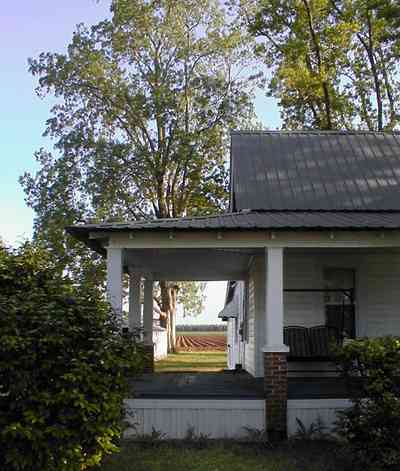
The fields can be seen from the side porch.
-

A small barn is located to the east of the main house.
-

The east side of the barn faces Highway 97.
-

Tiny pumpkins and giant pumpkins are for sale at the Whitfield farm.
-

Stan Whitfield poises with his scarcrow near a pile of 60 pound pumpkins.
-

-

The ranch has a typical red barn.
-

5 year old John Roush gets a riding lesson.
-

A ranch is a great place to be a kid.
-

John loved his lesson and was quite the little rider.
-

Trees line the old stagecoach route between Pensacola and Mobile.
-

The ranch has a lower end that is wetter and darker.
-

The wheat is green in late March and starts to turn a rich brown in April and is harvested in early May.
-

At this shooting, the wheat was about 3.5 feet high.
-

Grain silos rise in the distance as well as many other low farming buildings and simple homes and farm houses.
-
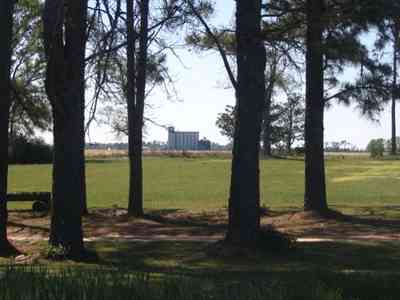
The giant Escambia grain elevator is about a mile away from this location on Kansas road.
-
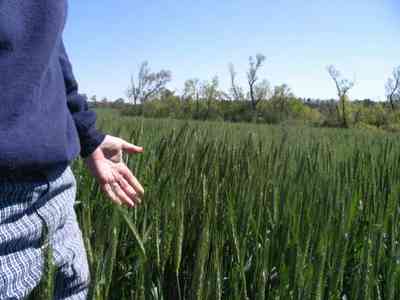
-

The Escambia Grain elevator is about 5 stories high and can be seen for miles around.
-
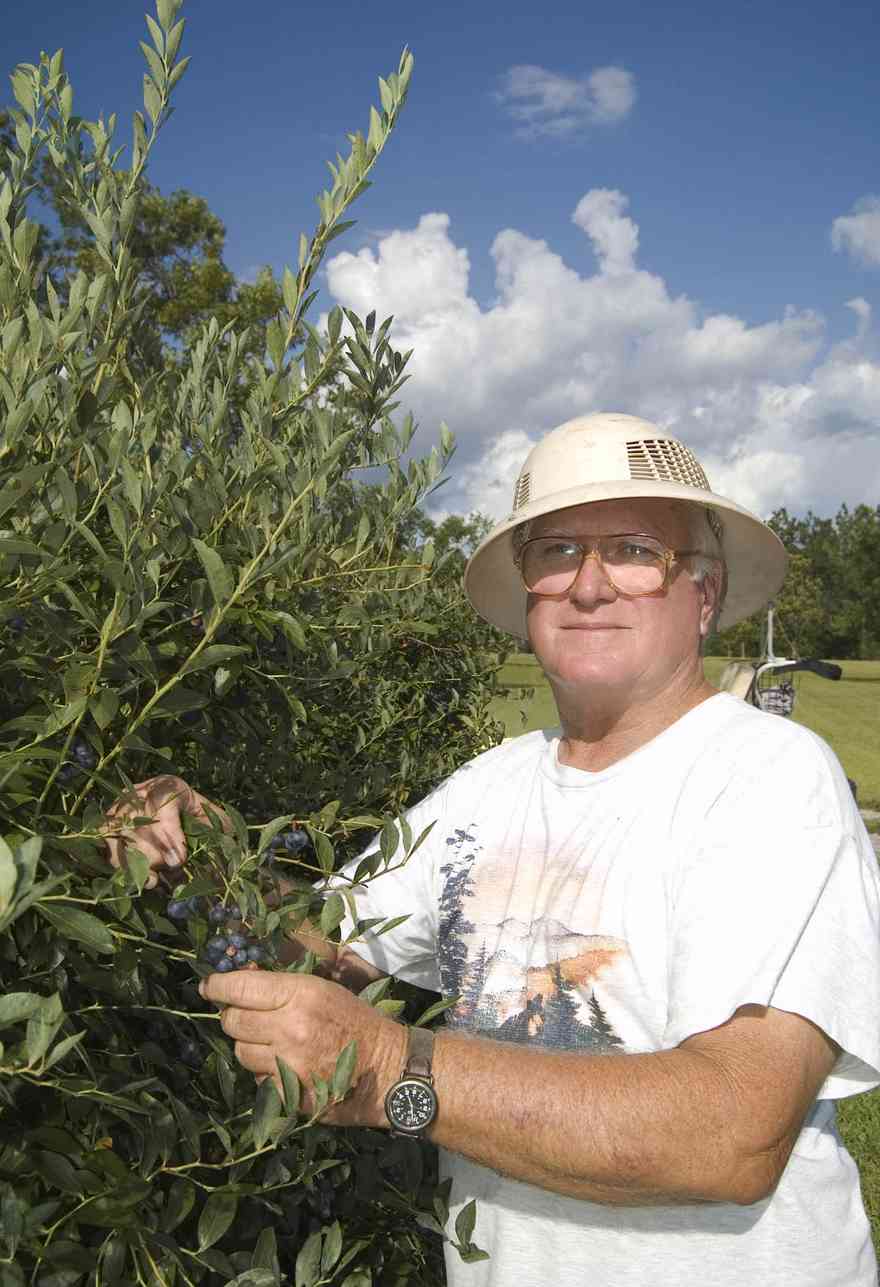
Highbush blueberries will grow upwards of 4 feet in height as mature plants and will yield large berries in late summer
-

The ideal blueberry plant should have at most sixteen canes - one or two for each year, up to eight years of growth.
-

Blueberries usually ripen over several weeks and require two to four pickings to harvest. Hand harvested fruits are picked once per week during most years or more frequently during hot weather.
-

Northwest Florida with 30 inches of annual rainfall usually gets enough rain to sustain the plants, unless summer dry spells stretch out past 60 days. Supplemental watering may be required.
-

Mennonites moved from Kansas to northern Escambia County. Their farms are well maintained and picturesque.
-

Round bales, which are typically weigh 700–900 lbs, are more moisture-resistant, and pack the hay more densely (especially at the center). Round bales are quickly fed with the use of mechanized equipment.
-
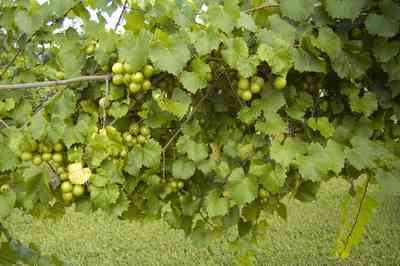
Muscadine jelly is a local favorite.






 The ranch is located on Highway 87 North.
The ranch is located on Highway 87 North. The picturesque ranch is a cattle farm.
The picturesque ranch is a cattle farm. Spanish moss hangs from the oak trees which form a tunnel over the road. For information about Spanish moss, click here.
Spanish moss hangs from the oak trees which form a tunnel over the road. For information about Spanish moss, click here.




 Whimsical sculptures and signs can be found on the Matthews farm.
Whimsical sculptures and signs can be found on the Matthews farm. The property is divided into fenced tracts.
The property is divided into fenced tracts. It is unusual to find limestone rocks on the surface in the area.
It is unusual to find limestone rocks on the surface in the area. There are about 100 head of cattle in this herd.
There are about 100 head of cattle in this herd. Steve Matthews feeds treats to the cows.
Steve Matthews feeds treats to the cows.


 Cattle graze on the extensive acreage.
Cattle graze on the extensive acreage.
 The farm is located on Hopewell Road.
The farm is located on Hopewell Road. There are two entrances on either side of Hopewell Road. This is the south gate.
There are two entrances on either side of Hopewell Road. This is the south gate. The south road is lined by an avenue of young live oak trees.
The south road is lined by an avenue of young live oak trees. The narrow dirt road is a private driveway.
The narrow dirt road is a private driveway. The road follows the gently rolling hills.
The road follows the gently rolling hills. There are several lakes in the valley. The road winds around the lakes.
There are several lakes in the valley. The road winds around the lakes.

 A branch of the Coldwater Creek flows through the Matthews property.
A branch of the Coldwater Creek flows through the Matthews property. The highway curves around newly planted fields.
The highway curves around newly planted fields. The farmland is located on a ridge of hills above the Blackwater River basin.
The farmland is located on a ridge of hills above the Blackwater River basin. The framed mirror hangs on a wall in the "dog trot" alongside of the kitchen door. It was used for grooming and shaving and was usually the only mirror in the house.
The framed mirror hangs on a wall in the "dog trot" alongside of the kitchen door. It was used for grooming and shaving and was usually the only mirror in the house. Bennie Barnes visits the Brown family.
Bennie Barnes visits the Brown family. Luke Brown is a champion calf roper on the rodeo circuit. He uses this trailer as headquarters on the road.
Luke Brown is a champion calf roper on the rodeo circuit. He uses this trailer as headquarters on the road. Luke Brown stands at the rear of his custom horse trailer.
Luke Brown stands at the rear of his custom horse trailer. The horse trailer is partitioned into a stall for the horse and living quarters for Luke.
The horse trailer is partitioned into a stall for the horse and living quarters for Luke. Luke's quarters are in the front of the trailer.
Luke's quarters are in the front of the trailer.



 Dan Stewart and associates act out a number from the movie, "Brother Where Art Thou".
Dan Stewart and associates act out a number from the movie, "Brother Where Art Thou". Customers buy bags of peanuts at the Holland barn.
Customers buy bags of peanuts at the Holland barn. The front of the farm faces Kleinschmidt Road. The deciduous trees are pecans. There is a grove along the property line on the east side of the farm. The Heil home is a small craftsman cottage in the center of the frame.
The front of the farm faces Kleinschmidt Road. The deciduous trees are pecans. There is a grove along the property line on the east side of the farm. The Heil home is a small craftsman cottage in the center of the frame. A dirt road runs alongside of the east field. Rolls of irrigatioin equipment and outbuildings can be seen in the right side of the frame. The greens can be seen int he center. There is a utility line alongside on the far left.
A dirt road runs alongside of the east field. Rolls of irrigatioin equipment and outbuildings can be seen in the right side of the frame. The greens can be seen int he center. There is a utility line alongside on the far left. The utility buildings and irrigation equipment can be seen in the distance along the tree line.
The utility buildings and irrigation equipment can be seen in the distance along the tree line.
 A pecan orchard frames the field of greens along the dirt road.
A pecan orchard frames the field of greens along the dirt road. Much of the produce in the area is grown in the Elberta farm community.
Much of the produce in the area is grown in the Elberta farm community. The dirt road and the farmland are barely distinguishable.
The dirt road and the farmland are barely distinguishable. An abandoned farmstead nestles among pecans and oaks beside the highway.
An abandoned farmstead nestles among pecans and oaks beside the highway. Pecan trees line the road. There are numerous old orchards on this flat plain.
Pecan trees line the road. There are numerous old orchards on this flat plain. The narrow dirt road runs alongside fields of vegetables
The narrow dirt road runs alongside fields of vegetables Piles of watermelons are purchased from July to August at the barn.
Piles of watermelons are purchased from July to August at the barn. Bruce and his family have a complete peanut harvest from planting through boiling.
Bruce and his family have a complete peanut harvest from planting through boiling. The 600 acre farm is divided into summer crops. The butterbean field is adjacent to the barn.
The 600 acre farm is divided into summer crops. The butterbean field is adjacent to the barn. Melvin Holland lends a hand during the butterbean harvest.
Melvin Holland lends a hand during the butterbean harvest. Charles Holland supervises the bagging of beans.
Charles Holland supervises the bagging of beans. Bruce and Melvin Holland are standing in one of the corn fields where the current crop is Silver King corn.
Bruce and Melvin Holland are standing in one of the corn fields where the current crop is Silver King corn. Melvin Holland samples the Silver King corn.
Melvin Holland samples the Silver King corn. Diane Holland cleans the Silver King corn. She is planning a cream style corn recipe.
Diane Holland cleans the Silver King corn. She is planning a cream style corn recipe. Produce such as, the cucumbers displayed by Bruce Holland is sold at the nearby barn.
Produce such as, the cucumbers displayed by Bruce Holland is sold at the nearby barn. Bruce Holland demonstrates soil quality in one of the north fields. The tilled area represents about five acres.
Bruce Holland demonstrates soil quality in one of the north fields. The tilled area represents about five acres. The field is being prepared for the next crop. Soil composition varies widely from field to field. The soil in this area has a high organic content. Soils are composed of sand, clay and organic materials.
The field is being prepared for the next crop. Soil composition varies widely from field to field. The soil in this area has a high organic content. Soils are composed of sand, clay and organic materials. The entrance to the barn and house is on the far right of the photograph. The 5 acre tilled field can be seen on the other side of the road.
The entrance to the barn and house is on the far right of the photograph. The 5 acre tilled field can be seen on the other side of the road. A crew of local workers pick the beans.
A crew of local workers pick the beans. Pods are cleaned automatically.
Pods are cleaned automatically. Zipper cream peas are a popular variety. Some seed varieties appear to have no distinguishing eye color or body color other than that of white or pale, these seeds are said to have “no color”, and they are classified as “Creams”. The color of the seed itself determines the color of the broth when cooked. The darker the seed color the darker the broth. Seed with “no color”, white or pale, gives a clear broth. Zipper Cream Peas have a clear colored broth. The name Zipper came from the ease of unzipping the pea pod to expose the seed.
Zipper cream peas are a popular variety. Some seed varieties appear to have no distinguishing eye color or body color other than that of white or pale, these seeds are said to have “no color”, and they are classified as “Creams”. The color of the seed itself determines the color of the broth when cooked. The darker the seed color the darker the broth. Seed with “no color”, white or pale, gives a clear broth. Zipper Cream Peas have a clear colored broth. The name Zipper came from the ease of unzipping the pea pod to expose the seed. The Bruce Holland farm complex is located on Homer Holland Road in Santa Rosa County, Florida. The peach trees seen in the photo produce about six bushels/60 pounds or 120 one-half pound peaches per tree.
The Bruce Holland farm complex is located on Homer Holland Road in Santa Rosa County, Florida. The peach trees seen in the photo produce about six bushels/60 pounds or 120 one-half pound peaches per tree. Bruce Holland is seen in the foreground of his peach orchard in northwest Florida. The trees have been planted in symmetrical rows every year for the past six years. The orchard has approximately 200 trees, all bearing fruit.
Bruce Holland is seen in the foreground of his peach orchard in northwest Florida. The trees have been planted in symmetrical rows every year for the past six years. The orchard has approximately 200 trees, all bearing fruit. The immature peaches shown above will be ready for picking in May and June, depending on the variety of tree. Mr. Holland also grows cantelopes, watermelons, butterbeans, peas, peanuts, and cotton. He has a booming retail business located out of his barn. The vegetable and fruit havest begins in May with the sale of peaches, cantelopes, and watermelons.
The immature peaches shown above will be ready for picking in May and June, depending on the variety of tree. Mr. Holland also grows cantelopes, watermelons, butterbeans, peas, peanuts, and cotton. He has a booming retail business located out of his barn. The vegetable and fruit havest begins in May with the sale of peaches, cantelopes, and watermelons.
 The peanut is a nitrogen-fixing plant. The roots form nodules, which absorb nitrogen from the air and provide enrichment and nutrition to the plant and soil.
The peanut is a nitrogen-fixing plant. The roots form nodules, which absorb nitrogen from the air and provide enrichment and nutrition to the plant and soil. From planting to harvesting the growing cycle takes about four to five months, depending on the variety.
From planting to harvesting the growing cycle takes about four to five months, depending on the variety. Peanuts are actually legumes - not nuts.
Peanuts are actually legumes - not nuts. Holland Farms produces a variety of crops throughout the year. Listed below are prices for vegetables that are currently being harvested. For further information, call - 675-6876.
Holland Farms produces a variety of crops throughout the year. Listed below are prices for vegetables that are currently being harvested. For further information, call - 675-6876.
 Bruce Holland inspects the cucumbers planted along a low fence.
Bruce Holland inspects the cucumbers planted along a low fence. Zipper cream peas are one of several varieties ready for harvesting.
Zipper cream peas are one of several varieties ready for harvesting. Green peanuts are available.
Green peanuts are available. Yellow crookneck squash grow in the garden south of the main barn.
Yellow crookneck squash grow in the garden south of the main barn. Royal Star and Starbright Watermelons are the varieties of watermelons grown for harvest.
Royal Star and Starbright Watermelons are the varieties of watermelons grown for harvest. This 15 acre field was planted in butterbeans. It is irrigated with water from a nearby holding pond.
This 15 acre field was planted in butterbeans. It is irrigated with water from a nearby holding pond. The irrigation line bisects a thirty acre field. The southern portion, show above, has been planted with pumpkins. The line of deciduous trees grow along Homer Holland Road.
The irrigation line bisects a thirty acre field. The southern portion, show above, has been planted with pumpkins. The line of deciduous trees grow along Homer Holland Road. The Holland farmhouse can be seen through the trees. The driveway is typical of dirt roads and driveways which are composed of red clay.
The Holland farmhouse can be seen through the trees. The driveway is typical of dirt roads and driveways which are composed of red clay. Hundreds of watermelons are sold at the barn every summer beginning in late June.
Hundreds of watermelons are sold at the barn every summer beginning in late June. Africa is considered to be the native home of the watermelon.
Africa is considered to be the native home of the watermelon. On the American continent, watermelons were grown as early as 1629 in Massachusetts, and prior to 1664 in Florida.
On the American continent, watermelons were grown as early as 1629 in Massachusetts, and prior to 1664 in Florida. Watermelons grow best on a sandy loam soil.
Watermelons grow best on a sandy loam soil. Today there are more than 100 different varieties of watermelons. The flesh may be red, pink, orange or yellow.
Today there are more than 100 different varieties of watermelons. The flesh may be red, pink, orange or yellow. The sweetest watermelons grow during long hot summers.
The sweetest watermelons grow during long hot summers. Ninety percent of watermelon is water.
Ninety percent of watermelon is water. Watermelon vines require considerable space. Seeds are planted one inch deep in hills spaced 6 feet apart. As the watermelon plants grows, the vines converge and the field becomes a sea of green vines.
Watermelon vines require considerable space. Seeds are planted one inch deep in hills spaced 6 feet apart. As the watermelon plants grows, the vines converge and the field becomes a sea of green vines. The watermelon require a long growing season with relatively high temperatures. Daytime temperatures between 70 and 80 degrees F and nighttime temperatures between 65 and 70 degrees F are ideal.
The watermelon require a long growing season with relatively high temperatures. Daytime temperatures between 70 and 80 degrees F and nighttime temperatures between 65 and 70 degrees F are ideal. Probably the most important indicator of ripeness is the underside which sets on the ground. Turn the melon over. It should be yellow or creamy colored on the underside. If it is white or pale green the melon is not ready to harvest.
Probably the most important indicator of ripeness is the underside which sets on the ground. Turn the melon over. It should be yellow or creamy colored on the underside. If it is white or pale green the melon is not ready to harvest. Once picked, uncut watermelon can be stored for about 2 weeks at room temperature.
Once picked, uncut watermelon can be stored for about 2 weeks at room temperature. The flesh of the melon should be deep colored with mature seeds. Most watermelons have dark brown or black seeds.
The flesh of the melon should be deep colored with mature seeds. Most watermelons have dark brown or black seeds. Harvesting is particularly critical because watermelons do not continue to ripen after they have been removed from the vine. They should be picked at full maturity.
Harvesting is particularly critical because watermelons do not continue to ripen after they have been removed from the vine. They should be picked at full maturity. Watermelons are low in calories and very nutritious. Watermelon is high in lycopene, second only to tomatoes.
Watermelons are low in calories and very nutritious. Watermelon is high in lycopene, second only to tomatoes. Watermelon is also high in Vitamin C and Vitamin A, in the form of disease fighting beta-carotene. Research also suggests that the red pigmented foods provide this protection.
Watermelon is also high in Vitamin C and Vitamin A, in the form of disease fighting beta-carotene. Research also suggests that the red pigmented foods provide this protection. Squash are harvested when five to six inches long. Keep the squash picked as flavor and texture will be inferior if the vegetable is left to grow to enormous size on the plant.
Squash are harvested when five to six inches long. Keep the squash picked as flavor and texture will be inferior if the vegetable is left to grow to enormous size on the plant. The Holland family settled the area over 100 years ago. Bruce Holland is a well known farmer who sells produce at his barn on Hwy 178. His farm has been featured on the WEAR TV 3 feature "Our Acre".
The Holland family settled the area over 100 years ago. Bruce Holland is a well known farmer who sells produce at his barn on Hwy 178. His farm has been featured on the WEAR TV 3 feature "Our Acre". The church is located at the corner of Chumukla Highway and 178.
The church is located at the corner of Chumukla Highway and 178. The little church is nestled between cotton fields in western Santa Rosa County.
The little church is nestled between cotton fields in western Santa Rosa County. Sycamore trees line Highway 178 at Sundance Farm.
Sycamore trees line Highway 178 at Sundance Farm. The range of the sycamore tree is northwest Florida and can be found throughout Santa Rosa and Escambia counties.
The range of the sycamore tree is northwest Florida and can be found throughout Santa Rosa and Escambia counties. The craftsman style cottage is evocative of the farm houses of the 1920's and 30's. It sits on the edge of a cotton field.
The craftsman style cottage is evocative of the farm houses of the 1920's and 30's. It sits on the edge of a cotton field. Americans are eating more peanuts overall; more peanut butter and more snack peanuts.Total peanut consumption has been on the upward trend since 1996. Snack peanuts are up by 13.3 percent over the past year.
Americans are eating more peanuts overall; more peanut butter and more snack peanuts.Total peanut consumption has been on the upward trend since 1996. Snack peanuts are up by 13.3 percent over the past year. The small town center features a line of unique brick store-fronts in red brick trimmed in yellow.
The small town center features a line of unique brick store-fronts in red brick trimmed in yellow. Melvin Holland sells peanuts at the festival.
Melvin Holland sells peanuts at the festival. There is a display of John Deere® tractors alongside of the farm museum.
There is a display of John Deere® tractors alongside of the farm museum. An original water well is located east of the farm house.
An original water well is located east of the farm house.





 There is an oak grove located on the west side of the property.
There is an oak grove located on the west side of the property. The entire western property line is shown in this photograph. The green field on the left is a winter wheat paddock.
The entire western property line is shown in this photograph. The green field on the left is a winter wheat paddock. The board fence separates the horse farm from the neighboring estate.
The board fence separates the horse farm from the neighboring estate. Interior fences are electrical, lined on the top with a white mesh tape.
Interior fences are electrical, lined on the top with a white mesh tape.
 There is a old growth forest of long-leaf pines surrounding the cleared acreage.
There is a old growth forest of long-leaf pines surrounding the cleared acreage.








 Womack Road is about three miles north of the town of Milton in Santa Rosa County.
Womack Road is about three miles north of the town of Milton in Santa Rosa County. There is a small restaurant about one mile from Munson Highway
There is a small restaurant about one mile from Munson Highway A windmill and chimney are all that remain at the old farmstead along a dirt road in northern Escambia County.
A windmill and chimney are all that remain at the old farmstead along a dirt road in northern Escambia County. Fields of winter wheat are planted as grazing land.
Fields of winter wheat are planted as grazing land.



 George Carpenter holds a 3 pound catfish which is an average size for the pond.
George Carpenter holds a 3 pound catfish which is an average size for the pond. Grace takes a rest with her mother, Kaye Perry, George and Martha's daughter.
Grace takes a rest with her mother, Kaye Perry, George and Martha's daughter. Donnie Waters is extracting the hook from the mouth of the catfish with the assistance of George Carpenter.
Donnie Waters is extracting the hook from the mouth of the catfish with the assistance of George Carpenter. Each catfish is weighed. The average catfish costs $1.50 per pound when the fish is caught at the pond.
Each catfish is weighed. The average catfish costs $1.50 per pound when the fish is caught at the pond. Mayor Bennie Barnes hooks a large catfish. He and Donnie Waters are planning a fish fry for Margorie Waters who is retiring from her job with the City of Century. It takes about an hour for the Mayor and Donnie to catch 20 fish.
Mayor Bennie Barnes hooks a large catfish. He and Donnie Waters are planning a fish fry for Margorie Waters who is retiring from her job with the City of Century. It takes about an hour for the Mayor and Donnie to catch 20 fish. Mayor Barnes carries his fish to the scales for weigh-in.
Mayor Barnes carries his fish to the scales for weigh-in. Mayor Barnes has the prize catch of the day.
Mayor Barnes has the prize catch of the day. Mayor Barnes records the weight of his prize catch just before it is cleaned.
Mayor Barnes records the weight of his prize catch just before it is cleaned. George Carpenter begins a demonstration of cleaning catfish by cutting off the spiny central fin.
George Carpenter begins a demonstration of cleaning catfish by cutting off the spiny central fin. The silo in the background holds 15 tons of catfish food. Catfish food is fed in pellet form. It is a high protein diet composed of fish meal, soybeans, corn, and wheat. In the summer, the catfish at the Carpenter pond consume a ton of food each day.
The silo in the background holds 15 tons of catfish food. Catfish food is fed in pellet form. It is a high protein diet composed of fish meal, soybeans, corn, and wheat. In the summer, the catfish at the Carpenter pond consume a ton of food each day. The feeding machine is mounted in the back of a pickup truck. Feed is sprayed about 20 feet over the pond. The small pellets are snapped up by the catfish. During the summer season, the fish can eat one ton of food per day.
The feeding machine is mounted in the back of a pickup truck. Feed is sprayed about 20 feet over the pond. The small pellets are snapped up by the catfish. During the summer season, the fish can eat one ton of food per day. This specatular sunset can be seen from the Carpenter's kitchen window.
This specatular sunset can be seen from the Carpenter's kitchen window. There is about 3,500 pounds per basket or 1,167 fish are retrived with each scoop.
There is about 3,500 pounds per basket or 1,167 fish are retrived with each scoop. There are no chemicals used in the pond. it is a totally controlled environment. A sample fish is sent to the processing plant for assessment. Tasters at the plant decide when the fish are ready for harvest. A select few fish from each load are ground up and anaylzed for chemicals by the USDA.
There are no chemicals used in the pond. it is a totally controlled environment. A sample fish is sent to the processing plant for assessment. Tasters at the plant decide when the fish are ready for harvest. A select few fish from each load are ground up and anaylzed for chemicals by the USDA. The oak canopy forms an umbrella over the home. John Michael Roush and Tiffy explore the yard.
The oak canopy forms an umbrella over the home. John Michael Roush and Tiffy explore the yard. Peanuts are grown on the 35 acre field adjacent to the homestead.
Peanuts are grown on the 35 acre field adjacent to the homestead. The boots were nailed to the trunk of the oak tree by Jeff Thompson's widow shortly after he died 25 years ago. He is the great-grandfather of John Michael Roush.
The boots were nailed to the trunk of the oak tree by Jeff Thompson's widow shortly after he died 25 years ago. He is the great-grandfather of John Michael Roush. The vernacular farmhouse can be seen as an attempt to return to the good old days, with a rocking chair on the front porch.
The vernacular farmhouse can be seen as an attempt to return to the good old days, with a rocking chair on the front porch. Charles Holland assists Bruce in the sales department.
Charles Holland assists Bruce in the sales department.
 Pecan trees divide the homestead's driveway from the adjacent fields.
Pecan trees divide the homestead's driveway from the adjacent fields.
 Corn is one of the crops grown in the Menonite community of Walnut Hill. There are several hundred acres of field corn planted for summer harvest on this farm.
Corn is one of the crops grown in the Menonite community of Walnut Hill. There are several hundred acres of field corn planted for summer harvest on this farm.
 A stand of pine trees can be seen on the left of the photograph. Cattle are grazing in the valley.
A stand of pine trees can be seen on the left of the photograph. Cattle are grazing in the valley. Walnut Hill is an area of gently rolling land settled by Mennonite farmers from Kansas.
Walnut Hill is an area of gently rolling land settled by Mennonite farmers from Kansas. Stalks range from 36 inches to 42 inches.
Stalks range from 36 inches to 42 inches. The plowed field is planted in winter wheat.
The plowed field is planted in winter wheat. Cattle graze on the winter wheat.
Cattle graze on the winter wheat. Rolls of hay can be seen on the left of the photograph.
Rolls of hay can be seen on the left of the photograph. The farm is located on Highway 97.
The farm is located on Highway 97. The house harmonizes with its surroundings because of low broad proportions and lack of ornamentation.
The house harmonizes with its surroundings because of low broad proportions and lack of ornamentation. The facade of the home faces west. There is an overstory of large water oaks. An adjoining garage apartment can be seen at the end of the driveway with the barn immediately to the rear.
The facade of the home faces west. There is an overstory of large water oaks. An adjoining garage apartment can be seen at the end of the driveway with the barn immediately to the rear. The style of architecture is often referred to as Craftsman. These dwellings display a fine degree of craftsmanship and are constructed of materials left as close as possible to their natural state.
The style of architecture is often referred to as Craftsman. These dwellings display a fine degree of craftsmanship and are constructed of materials left as close as possible to their natural state. The walls are laid in quarried stone.
The walls are laid in quarried stone. The conical building is used for drying corn.
The conical building is used for drying corn. The lean-to on the side of the barn is used as a chicken coop.
The lean-to on the side of the barn is used as a chicken coop. The driveway off Highway 97 is on the left of the photograph.
The driveway off Highway 97 is on the left of the photograph. Oak trees line the cotton field adjacent to the Escambia Grain Coop silos.
Oak trees line the cotton field adjacent to the Escambia Grain Coop silos. This is the only farm cooperative grain elevator in northwest Florida.
This is the only farm cooperative grain elevator in northwest Florida. There are three main buildings in the complex. The office is on the left, the grain elevator is immediately behind the office building and the fertilizer house is on the right of the photograph.
There are three main buildings in the complex. The office is on the left, the grain elevator is immediately behind the office building and the fertilizer house is on the right of the photograph. The opening under the main structure is the main access for loading and unloading truck loads of farm products.
The opening under the main structure is the main access for loading and unloading truck loads of farm products. Trucks enter and stop at the office for a weigh-in to establish the amount of product before unloading.
Trucks enter and stop at the office for a weigh-in to establish the amount of product before unloading. The soybeans are unloaded into "the pit", a 30' underground storage space. Commodities are purchased from the farmers, stored and sold to consumers in amounts up to 5 tons.
The soybeans are unloaded into "the pit", a 30' underground storage space. Commodities are purchased from the farmers, stored and sold to consumers in amounts up to 5 tons. The same area serves as a loading bay. A flow of corn is released from the storage silo. Customers range from hunters and farmers to sales of corn by the truckload, shipped overseas from the port in nearby Mobile.
The same area serves as a loading bay. A flow of corn is released from the storage silo. Customers range from hunters and farmers to sales of corn by the truckload, shipped overseas from the port in nearby Mobile. This small elevator services the main silo.
This small elevator services the main silo. The pipes feed into 18 different bins, storing individual items, such as, wheat oats, milo, soybeans and corn. Corn is the main item in storage at the elevator.
The pipes feed into 18 different bins, storing individual items, such as, wheat oats, milo, soybeans and corn. Corn is the main item in storage at the elevator. The conveyor belt moves corn up to the top floor of the grain elevator. The belt must be cleaned by hand.
The conveyor belt moves corn up to the top floor of the grain elevator. The belt must be cleaned by hand. The conveyor belt runs the length of the bins.
The conveyor belt runs the length of the bins. An auger turns the dispensing chute.
An auger turns the dispensing chute. The bins are numbered and the feeding tube is positioned over the correct storage area.
The bins are numbered and the feeding tube is positioned over the correct storage area. White corn dust covers surfaces in the elevator.
White corn dust covers surfaces in the elevator. A spectacular view of Walnut Hill can be seen from the top of the silos. Hundreds of acres of farmland stretch to the northern horizon.
A spectacular view of Walnut Hill can be seen from the top of the silos. Hundreds of acres of farmland stretch to the northern horizon. Fertilizer is stored, mixed and sold in a seperate building. The bags shown above are loaded by hand after customing the mixture of the elements, such as, amonium nitrate, potash, etc.
Fertilizer is stored, mixed and sold in a seperate building. The bags shown above are loaded by hand after customing the mixture of the elements, such as, amonium nitrate, potash, etc. The bobcat is used to load scoops of ingredients in the fertilizer mix.
The bobcat is used to load scoops of ingredients in the fertilizer mix. Clay Stuckey demonstrates one of the tasks in the fertilizer house. The fertilizer is dumped into this grate. A scale weighs the material and it is mixed in a hopper. The finished product is distributed by truckload or by 50 pound bag.
Clay Stuckey demonstrates one of the tasks in the fertilizer house. The fertilizer is dumped into this grate. A scale weighs the material and it is mixed in a hopper. The finished product is distributed by truckload or by 50 pound bag. Pre-packaged materials in 50 pound bags are stored in the building adjacent to the front office. The bags contain fertilizer and seed, as well as feed for any livestock.
Pre-packaged materials in 50 pound bags are stored in the building adjacent to the front office. The bags contain fertilizer and seed, as well as feed for any livestock. After unloading, the truck is weighed empty to establish the amount of the load. The amount of the sale depends on current market price. A ticket is added to the farmer's account.
After unloading, the truck is weighed empty to establish the amount of the load. The amount of the sale depends on current market price. A ticket is added to the farmer's account. The rear door to the office is located to the right in the photograph.
The rear door to the office is located to the right in the photograph. The scales are connected to an electronic weighing system in the office.
The scales are connected to an electronic weighing system in the office. Five employees run the elevator operations. Merle and Clay are in charge of outside tasks. There are two secretaries, Sue and Evon, as well as a general manager, Ed Nowlin. The elevator provides a central meeting place for some members of the farm community.
Five employees run the elevator operations. Merle and Clay are in charge of outside tasks. There are two secretaries, Sue and Evon, as well as a general manager, Ed Nowlin. The elevator provides a central meeting place for some members of the farm community. Gobbler Road is in the Walnut Hill Community off Highway 97.
Gobbler Road is in the Walnut Hill Community off Highway 97. There are thousands of acres in cultivation in the Walnut Hill community planted in a variety of crops.
There are thousands of acres in cultivation in the Walnut Hill community planted in a variety of crops. The 60 acre field is located on Highway 97 in the Walnut Hill community.
The 60 acre field is located on Highway 97 in the Walnut Hill community.



 There are several dairy farms along Kansas Road.
There are several dairy farms along Kansas Road. Round hay bales dot the fields near Walnut Hill.
Round hay bales dot the fields near Walnut Hill. There are catfish ponds on both sides of the dirt road.
There are catfish ponds on both sides of the dirt road. The pond is the foreground is one of many catfish ponds in the area. There are over 1,000 such ponds in the neighborhood.
The pond is the foreground is one of many catfish ponds in the area. There are over 1,000 such ponds in the neighborhood.
 All of the land fronting on Kansas Road is under cultivation as row crops or in use as pasture land.
All of the land fronting on Kansas Road is under cultivation as row crops or in use as pasture land. There are cotton fields stretching for several miles on both sides of Kansas Road.
There are cotton fields stretching for several miles on both sides of Kansas Road. Mennonite farmers are making agriculture a viable way of life in Escambia County.
Mennonite farmers are making agriculture a viable way of life in Escambia County. Mike Godwin stands next to an airplane that he is rebuilding.
Mike Godwin stands next to an airplane that he is rebuilding.


 The corn crop will be used for silage to feed dairy cattle.
The corn crop will be used for silage to feed dairy cattle.
 The Van Pelt Dairy Farm is located on Highway 97 in the Walnut Hill community.
The Van Pelt Dairy Farm is located on Highway 97 in the Walnut Hill community. Hundreds of acres of feed corn are grown along Highway 97.
Hundreds of acres of feed corn are grown along Highway 97. In between corn fields there are pastures were the dairy cows graze.
In between corn fields there are pastures were the dairy cows graze. Corn fields front Highway 97 for several miles.
Corn fields front Highway 97 for several miles. The south end of the Van Pelt Dairy Farm is bordered by Gobbler Road. There are approximately three miles of corn fields along Gobbler Road which end to the east on Sandy Hollow Road.
The south end of the Van Pelt Dairy Farm is bordered by Gobbler Road. There are approximately three miles of corn fields along Gobbler Road which end to the east on Sandy Hollow Road. The heifer barn is on the right. The milking barn is in the center of the frame.
The heifer barn is on the right. The milking barn is in the center of the frame. The cows are leaving the milking barn. They are milked in shifts of 16 cows. The entire herd is processed between 1:40 a.m. and 6:30 a.m. and again in the afternoon beginning at 1:00 p.m. finishing around 5:30 p.m..
The cows are leaving the milking barn. They are milked in shifts of 16 cows. The entire herd is processed between 1:40 a.m. and 6:30 a.m. and again in the afternoon beginning at 1:00 p.m. finishing around 5:30 p.m.. There are three milkers who work in two shifts every day.
There are three milkers who work in two shifts every day. Jan McCune places the milking machine on the cow’s udders. The machine pulls a 30 pound pressure to complete the evacuation process in 5 to 15 minutes depending on the quanitity of milk.
Jan McCune places the milking machine on the cow’s udders. The machine pulls a 30 pound pressure to complete the evacuation process in 5 to 15 minutes depending on the quanitity of milk. Jan gets a “kiss” from her favorite Mama cow, No. 62. Cows wear collars and are named by number.
Jan gets a “kiss” from her favorite Mama cow, No. 62. Cows wear collars and are named by number. No. 62 is a friendly cow. The cows are in a holding pen, waiting to be called into the milking barn.
No. 62 is a friendly cow. The cows are in a holding pen, waiting to be called into the milking barn. Cleaning the milking barn floor during shifts is a continous task.
Cleaning the milking barn floor during shifts is a continous task. Jan explains the gestation tabulator. The cycles and pregnancy of each cow is plotted.
Jan explains the gestation tabulator. The cycles and pregnancy of each cow is plotted. George Van Pelt demonstrates the process of artificial insemination.
George Van Pelt demonstrates the process of artificial insemination. The farm is located on Highway 97 in the Walnut Hill community.
The farm is located on Highway 97 in the Walnut Hill community. The farm buildings are surrounded by extensive fields in spring cultivation.
The farm buildings are surrounded by extensive fields in spring cultivation. The small farmhouse exhibits traditional Craftsman architectural style.
The small farmhouse exhibits traditional Craftsman architectural style. The house is framed with an overstory of pecan trees.
The house is framed with an overstory of pecan trees. The fields can be seen from the side porch.
The fields can be seen from the side porch. A small barn is located to the east of the main house.
A small barn is located to the east of the main house. The east side of the barn faces Highway 97.
The east side of the barn faces Highway 97. Tiny pumpkins and giant pumpkins are for sale at the Whitfield farm.
Tiny pumpkins and giant pumpkins are for sale at the Whitfield farm. Stan Whitfield poises with his scarcrow near a pile of 60 pound pumpkins.
Stan Whitfield poises with his scarcrow near a pile of 60 pound pumpkins.
 The ranch has a typical red barn.
The ranch has a typical red barn. 5 year old John Roush gets a riding lesson.
5 year old John Roush gets a riding lesson. A ranch is a great place to be a kid.
A ranch is a great place to be a kid. John loved his lesson and was quite the little rider.
John loved his lesson and was quite the little rider. Trees line the old stagecoach route between Pensacola and Mobile.
Trees line the old stagecoach route between Pensacola and Mobile. The ranch has a lower end that is wetter and darker.
The ranch has a lower end that is wetter and darker. The wheat is green in late March and starts to turn a rich brown in April and is harvested in early May.
The wheat is green in late March and starts to turn a rich brown in April and is harvested in early May. At this shooting, the wheat was about 3.5 feet high.
At this shooting, the wheat was about 3.5 feet high. Grain silos rise in the distance as well as many other low farming buildings and simple homes and farm houses.
Grain silos rise in the distance as well as many other low farming buildings and simple homes and farm houses. The giant Escambia grain elevator is about a mile away from this location on Kansas road.
The giant Escambia grain elevator is about a mile away from this location on Kansas road.
 The Escambia Grain elevator is about 5 stories high and can be seen for miles around.
The Escambia Grain elevator is about 5 stories high and can be seen for miles around. Highbush blueberries will grow upwards of 4 feet in height as mature plants and will yield large berries in late summer
Highbush blueberries will grow upwards of 4 feet in height as mature plants and will yield large berries in late summer The ideal blueberry plant should have at most sixteen canes - one or two for each year, up to eight years of growth.
The ideal blueberry plant should have at most sixteen canes - one or two for each year, up to eight years of growth. Blueberries usually ripen over several weeks and require two to four pickings to harvest. Hand harvested fruits are picked once per week during most years or more frequently during hot weather.
Blueberries usually ripen over several weeks and require two to four pickings to harvest. Hand harvested fruits are picked once per week during most years or more frequently during hot weather. Northwest Florida with 30 inches of annual rainfall usually gets enough rain to sustain the plants, unless summer dry spells stretch out past 60 days. Supplemental watering may be required.
Northwest Florida with 30 inches of annual rainfall usually gets enough rain to sustain the plants, unless summer dry spells stretch out past 60 days. Supplemental watering may be required. Mennonites moved from Kansas to northern Escambia County. Their farms are well maintained and picturesque.
Mennonites moved from Kansas to northern Escambia County. Their farms are well maintained and picturesque. Round bales, which are typically weigh 700–900 lbs, are more moisture-resistant, and pack the hay more densely (especially at the center). Round bales are quickly fed with the use of mechanized equipment.
Round bales, which are typically weigh 700–900 lbs, are more moisture-resistant, and pack the hay more densely (especially at the center). Round bales are quickly fed with the use of mechanized equipment. Muscadine jelly is a local favorite.
Muscadine jelly is a local favorite. One Tank of Gas
One Tank of Gas